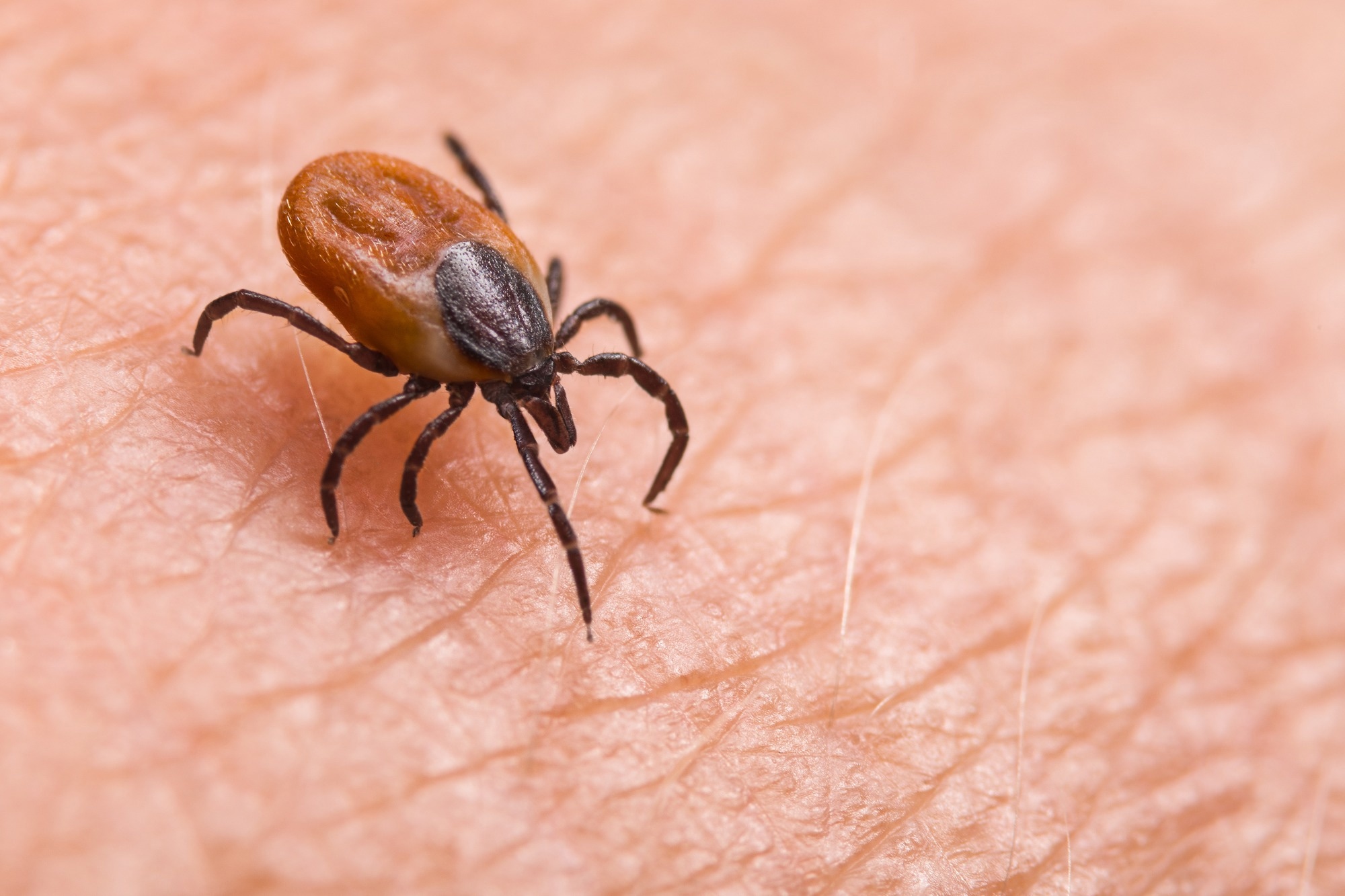In a recent study published in the Scientific Reports Journal, researchers combined experimental tick feeding with tick evaluations from wild white-tailed deer (Odocoileus virginianus) to determine whether ticks may contain transmission-relevant amounts of chronic wasting disease (CWD)-associated prions (PrPCWD).
 Study: Ticks harbor and excrete chronic wasting disease prions. Image Credit: KPixMining/Shutterstock.com
Study: Ticks harbor and excrete chronic wasting disease prions. Image Credit: KPixMining/Shutterstock.com
Background
Natural means of the spread of CWD among free-roaming cervids have not been extensively investigated, and they may prolong the endemic increase and the disease's vast geographic distribution.
Because cervids can carry significant tick infestations and exhibit allogrooming, a common tick defense technique between conspecifics, the presence of PrPCWD in the blood may constitute a danger for indirect transmission via hematophagous ectoparasites functioning as mechanical vectors. The contribution of ticks as mechanical carriers of CWD is unknown.
About the study
The present study investigated whether ticks harbor and excrete CWD prions and contribute to their indirect transmission.
Pathogen-free Ixodes scapularis (black-legged tick) female and male adults were housed and fed a blood meal inoculated with a 10-3 dilution of CWD-positive brain (106 ng). They were exposed to CWD through membrane feeding.
Subsequently, ear tissue and ticks attached to hunter-harvested, wild white-tailed deer were obtained. Tick, blood, frass, and ear tissue homogenates were prepared for real-time quaking-induced conversion assays (RT‑QuIC). CWD status was determined using enzyme-linked immunosorbent assays (ELISA).
Protein misfolding cyclic amplification (PMCA) assays were performed to cross-analyze the pooled engorged tick samples tested by RT-QuIC. Genomic deoxyribonucleic acid (DNA) was extracted from the ear tissues, and the prion protein (PRNP) gene sequence was amplified using polymerase chain reaction (PCR).
The researchers evaluated whether they could retrieve and identify CWD-associated prions from the spiked blood and tick homogenates as opposed to the CWD-infected tissue or the brain, i.e., the source tissue and whether the rates of recovery varied depending on the sample type (CWD-infected brain, prion-spiked homogenates from ticks, or spiked blood).
Relationships between the type of sample and dilution were included to investigate whether detection or recovery was responsive to sample quantity throughout the series of tenfold dilutions.
Subsequently, the researchers investigated whether ticks fed blood implanted with CWD-infected brain homogenate could absorb and release prions.
Amyloid Formation Rate (AFR) results were compared according to the type of sample (CWD-infected tissue of the brain, frass obtained from experimentally fed tick species, and ticks feeding on prion-infected blood) and the relationships between the type and dilution of the samples.
Further, the team investigated whether the status of CWD could be determined using simpler to obtain tissues (for example, ectoparasites or ear tissues), which might offer support for less intrusive antemortem chronic wasting disease testing.
RT-QuIC mean AFRs were obtained from the deer for the three types of sample types (pooled tick specimens, ear tissues, and lymph nodes) to determine correlations in the AFRs (i.e., whether deer who had elevated AFRs in the lymph nodes had greater AFRs in tick or ear samples in comparison with deer who had reduced AFRs). Linear regression modeling was performed for the analysis.
Furthermore, using the estimated quantity of PrPCWD seeding substance in the samples concerning the experimentally established per-tick infectious dose (ID50) for a comparable quantity of material within the brain, the team calculated whether prion levels found among ticks from freely roaming deer could cause infections.
Results
The artificial membrane feeding assays showed that I. scapularis could ingest and excrete PrPCWD. The specificity and sensitivity of PrPCWD-exposed ticks with RT-QuIC could validate the absence or presence of PrPCWD among wild-fed ticks.
The RT-QuIC and PCMA assay results showed seeding activity in 40% (six out of 15) of pooled tick samples, which were obtained from Odocoileus virginianus infected with CWD. The findings indicated a 7.0% to 40% CWD prevalence in Ixodes scapularis that had fed on CWD-infected white-tailed deer.
The findings indicated that a single black-legged tick that fed on a CWD-infected white-tailed deer could contain 0.30 to 42 ID50, indicating that tick consumption by deer during bouts of allogrooming might facilitate oral exposure of PrPCWD from ticks consuming blood meals from CWD-infected deer.
RT-QuIC seeding activities among wild-fed ticks were analogous to 10.0 to 1,000.0 ng of CWD-infected retropharyngeal lymph node (RPLN) from every animal, and the peripheral samples were less sensitive to RPLN using RT-QuIC. The quantity of PrPCWD present in tick samples was near the detection threshold for each method.
The optimization methods for whole blood and blood-engorged ticks allowed for sensitive and specific detection of PrPCWD from the sample types by RT-QuIC for the spiking experiments. However, differences in sensitivity were obtained for the two assays, which detected only one sample in common.
The PRNP genotype may have influenced the naturally occurring PrPCWD loads from ticks and ear tissue obtained from the 15 CWD-positive white-tailed deer.
The four positive PCMA results for the same pooled tick samples showed the detection of PrPCWD in one CWD-positive 96G/96S and three CWD-positive 96G/96G. Prion loads were different in each animal based on the RPLN dilution series.
Conclusion
Overall, the study findings showed that infection-relevant loads of seeding substances are present in individual ticks.
The findings could inform CWD research and adaptive management efforts and deepen our understanding of ecologically critical drivers of CWD dynamics.
Future studies could evaluate the rate, preferences, and frequency of cervid allogrooming across different cervid species to improve our understanding of host behavior, the status of the disease, and conspecific exposure risk.